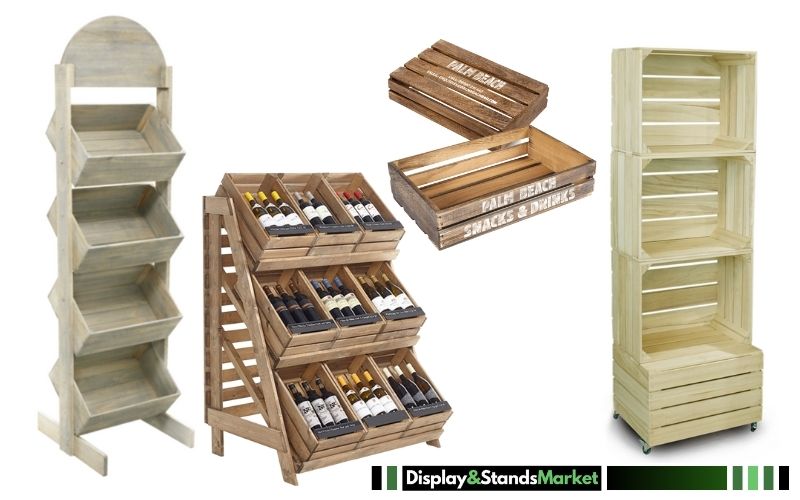When it comes to creating an attractive and organized display in retail, Horeca, or event settings, wooden crate display stands are a popular choice. From crate shelves to countertop crate stands, there are many different types of display stands that use crates to showcase products.
However, with so many options available, it can be difficult to understand the differences between each type. That’s why we’ve Display Stands Market team put together this dictionary of various types of wooden crate display stands to help you navigate the world of crate displays.
This dictionary will be helpful whether you’re a retailer, event planner, or simply someone looking to create an organized display in your home. It will help you understand the different types of wooden crate display stands and help you make the best choice.
So, let’s dive in and explore the world of wooden crate display stands.
List of wooden crate display stands:
- Wooden crate display stands
- Wooden crate shelves
- Wooden crate stands
- Countertop crate stand
- Wooden display crate
- Nesting crates for product display
Wooden crate display stands
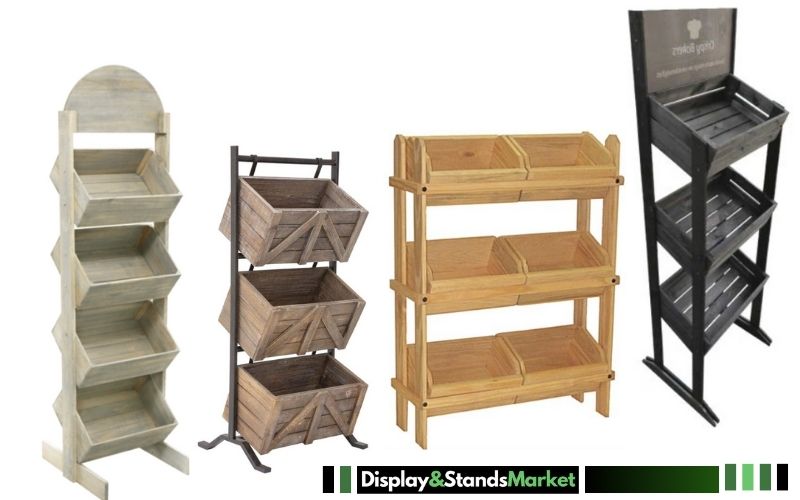
A wooden crate display stand is a type of product display stand that features wooden crates as shelves. Wooden crate stands are commonly used in retail stores and craft fairs to showcase a variety of small products such as fruits, vegetables, baked goods, and handmade crafts that are best displayed in boxes.
The stand typically consists of a wooden frame with multiple wooden crates attached to it as shelves, arranged in a step-like pattern to create a visually appealing display. The crates are angled, allowing products to be easily seen and accessed by customers.
What does a wooden crate display stand look like
Wooden crate stands are typically composed of a wooden or steel frame with angled wooden crates fixed and arranged vertically to create multiple levels for displaying merchandise. The crates are often left unpainted or lightly sanded to give a rustic, natural appearance.
Some wooden crate display stands may include additional elements such as hooks, shelves, or signage to enhance the display and make it more functional. The key characteristic that set wooden crate stands apart from other product display stands is their safety for products and their suitability for small boxed products.
What materials are wooden crate display stands made of
Wooden crate display stands are most commonly made from natural wood such as pine, oak, or cedar, which is strong, durable, and able to support the weight of the merchandise. Some manufacturers may use engineered wood products like plywood or particleboard to reduce costs, but these materials may not be as durable as solid wood.
Additionally, some wooden crate display stands may be made from reclaimed or recycled wood, which adds to their rustic charm and sustainability. This is the experience of wooden box stand manufacturer Color Wood Latvia. It thinks about a sustainable approach in every step of production.
A display stand frame can also be produced from other materials, such as steel, depending on the desired look and durability.
What are wooden crate display stands best for
Crate display stands are ideal for displaying small products that are best displayed in boxes and need to be kept safe within the display stand. It is also well suited for bottles.
They are commonly used in retail stores, farmers’ markets, and craft fairs to display small items such as fruits, vegetables, baked goods, and handmade crafts. Wooden crate stands are also a popular choice for businesses that want to create a rustic and natural ambiance in their product displays.
Similar products as wooden crate display stands
Wooden crate display stands may also be called as crate displays or crate fixtures.
Here are also some similar products to wooden crate display stands:
- Crate shelves – Display stands that are made from wooden crates. See more in the following section.
- Wire basket displays – they feature wire baskets that are stacked or arranged to create multiple levels for displaying merchandise.
- Metal grid displays – these displays use wire grids that are attached to metal frames to create a versatile and customizable display.
- Wooden pallet displays – wooden pallets that are stacked or arranged to create a rustic and functional display.
However, unlike wooden crate stands, these products may offer a different level of safety for small boxed products.
Wooden crate shelves
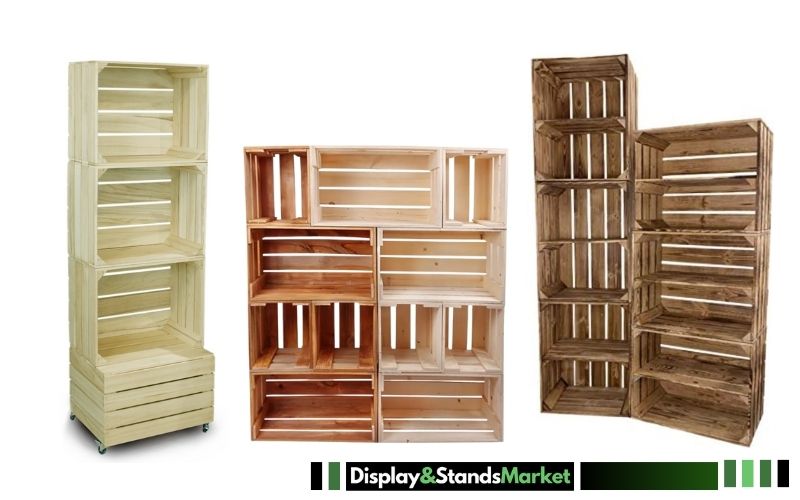
A wooden crate shelf is a type of storage or display unit made from wooden crates stacked and assembled to form a larger structure. This structure can be used to display products, books, or other items in a creative and rustic way.
Crate shelves can be assembled in various sizes and shapes, depending on the intended use and available space.
What do crate shelves look like
Crate shelves typically consist of several wooden crates stacked on top of each other in a way that creates a stable structure. The crates can be arranged in a uniform pattern or in a more creative, asymmetrical form.
The crates can be left in their natural wooden state or painted or stained to match the room’s décor. They are often secured with screws or brackets to ensure stability and prevent the crates from shifting or falling.
What materials are crate shelves made of
As the name indicates, these shelving units are typically made of wooden crates that can be made from various types of wood, including pine, oak, or poplar. These woods are popular because they are sturdy and durable, making them ideal for holding heavy objects or large volumes of books.
Some crate shelves may also include metal brackets or framing elements to add extra stability and durability.
What crate shelves are best for
Crate shelves are a popular choice for retail, market stalls, and Horeca (hotels, restaurants, cafes) settings because they offer a rustic and creative way to display products or decor. They can be used to hold books, dishes, or other items in an organized and eye-catching way.
Crate shelves are also popular in event settings, such as weddings or parties, where they can be used to hold favors or display photos. In home decor, they can be used to hold plants, organize entryways or create unique wall art.
Similar products as crate shelves
Crate shelves are sometimes called crate displays, crate storage units, or simply wooden crate shelves.
But very similar products to crate shelves are:
- Wooden pallet shelves – made from repurposed pallets offer a similar rustic look.
- Industrial pipe shelves – use metal pipes and fittings to create a more modern and industrial look.
Unlike crate shelves, these alternatives may require a bit more technical skill and assembly to create.
Wooden crate stand

A wooden crate stand is a durable frame designed to hold multiple wooden crates for retail. It is used to create an attractive, functional, and visually appealing product display. The stand allows for easy restocking of products by simply replacing the full crate with a new one from storage or the warehouse.
What does a wooden crate stand look like
A wooden crate stand typically has a rectangular or square shape with a flat base and open sides. It is designed to hold several wooden crates that can be easily accessed and restocked.
The stand may have a solid top or be open at the top, depending on the desired look and function. The stand is typically made of wood and can be stained or painted to match a specific theme or branding.
What materials are wooden crate stands made of
Wooden crate stands are typically made of wood, such as pine, oak, or birch. These wood materials are well known for their strength, durability, and natural look.
Some wooden crate stands may also include metal or plastic elements for added stability or design purposes. For example, metal corner braces can be added to reinforce the structure of the crate stand, while plastic feet can protect floors from scratches.
What are wooden crate stands best for
Wooden crate stands are ideal for retail, providing an organized and visually appealing display. They allow for easy restocking of products, as full crates can be easily replaced with new ones.
Some crate stands can also be featured with wheels or foldable construction to add extra mobility. That will make them well-suited for street markets, market stalls, or trade shows.
Similar products as wooden crate stands
Wooden crate stands may also be referred to as crate holders or crate racks.
Similar products to wooden crate stands include:
- Wire crate displays – similar to wooden crate stands in that they hold multiple crates and have an open structure. However, wire displays are typically made of metal and may not have the same natural look as wooden crate stands.
- Plastic crate displays – similar to wooden crate stands in that they hold multiple crates, but they are made of plastic and may not have the same durability as wooden crate stands.
Countertop crate stand
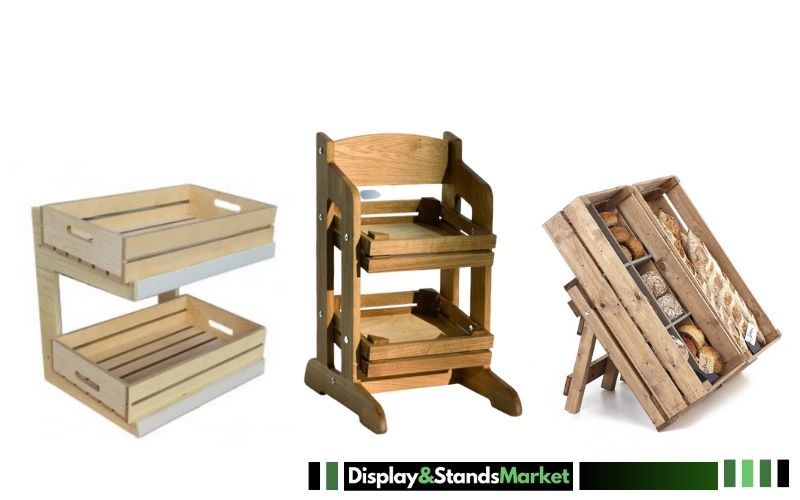
A countertop crate stand is a display stand used for presenting products in convenience stores, cafes or trade shows. It is a raised platform designed to hold items, such as fruits, snacks, baked goods, or other products that require a visually appealing presentation.
The countertop crate stand is usually placed on a countertop or table, making it easy to access for customers.
What does a countertop crate stand look like
Countertop crate stands are typically made of wood and designed to resemble a crate or a box. They feature an open top and four sides with slats that allow for airflow and easy viewing of the products inside.
The stand can come in either one or two levels, depending on the desired display and storage capacity. It usually has legs or a base that elevates it off the surface it sits on, providing additional visibility for the products.
Countertop crate stands may also come with a variety of finishes, including natural wood, painted or stained finishes, or distressed finishes, depending on the desired aesthetic.
What materials countertop crate stands are made of
Countertop crate stands are primarily made of wood, but other materials such as metal, plastic, and acrylic can also be used for specific durable elements such as feet or signage.
The most common type of wood used is pine due to its affordability and durability. Hardwoods like oak, maple, and cherry can also be used for a more luxurious look. Metal components like feet, hinges, and locks are usually made of stainless steel or iron. Signage can be made of acrylic or plastic.
What countertop crate stands are best for
Countertop crate stands are best for displaying products in an attractive and organized manner. They are commonly used in retail settings to display fresh produce, baked goods, or other merchandise.
They are also popular in Horeca (hotel, restaurant, and cafe) settings, where they are used to present menu items or buffet items. In the event industry, they can be used for displaying promotional items or company swag.
Similar products as countertop crate stand
Countertop crate stands may also be called table-top crate stands or crate risers.
Similar products to countertop crate stands include:
- Wooden boxes – similar to crate stands but may have a lid or handle for easy transport. Those can be made from plywood, cupboard, or plastic.
- Wooden tiered stands – typically used for displaying desserts, fruits, or other small items and feature multiple levels for added visibility.
Wooden display crate
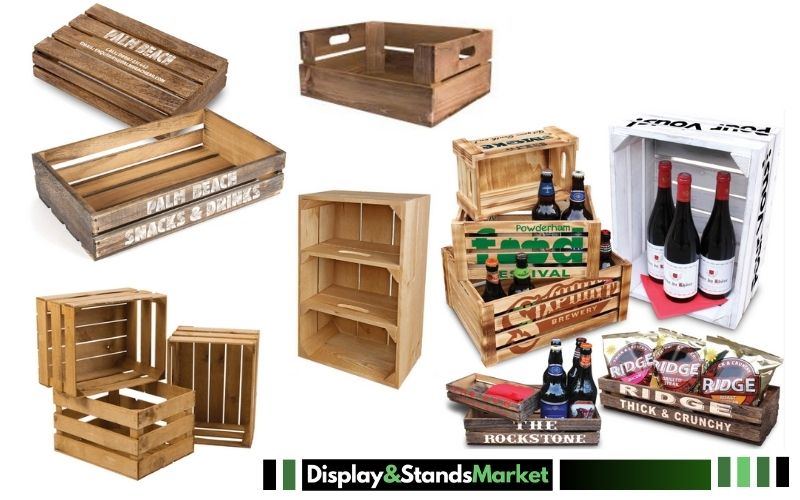
A wooden display crate is a container used to display and showcase products in a retail, Horeca, or event setting. These crates are designed to be both functional and aesthetically pleasing. It focuses on showcasing the products inside while also providing a sturdy and durable storage solution.
Wooden display crates are typically made from high-quality wood and are designed to be easily stackable and transportable.
What does a wooden display crate look like
Wooden display crates are typically rectangular in shape, with a flat bottom and four walls that are slightly angled inward. They are designed to be easily stackable, with a lip or groove along the top edge of each crate. That allows them to be securely stacked on top of one another.
The walls of a wooden display crate may be solid or slatted, with slatted walls providing increased visibility of the products inside. Wooden display crates may be left natural or may be painted or stained to match the décor of the premises or company design.
What materials are wooden display crates made of
As the product name indicates, wooden display crates are typically made from wood, such as pine, oak, or birch. The wood may be left natural or may be stained or painted to match the decor of the space. It is common to paint them with product or business branding.
In some cases, other materials may be used to reinforce specific elements of the crate, such as metal brackets or additional signage.
The choice of material will depend on the intended use of the crate, with more durable materials being better suited for heavy-duty use. For example, if crates are panned to use in market stalls.
What are wooden display crates best for
They are commonly used to display food items such as fruits and vegetables, baked goods, and artisanal products such as cheeses and wines. Wooden display crates may also be used to display non-food items such as clothing, home décor, and personal care products.
Similar products as wooden display crates
Wooden display crates may also be called display bins, display boxes, or display cases. These terms are often used interchangeably, although they may imply slight differences in the design or use of the container.
Similar products to wooden display crates include:
- Plastic bins – may be more lightweight and durable. In some cases also cheaper.
- Acrylic display cases – may be used to showcase high-value or fragile items that require additional protection.
While these products may serve a similar purpose to wooden display crates, they may differ in terms of aesthetics, durability, or functionality.
Nesting crates for product display
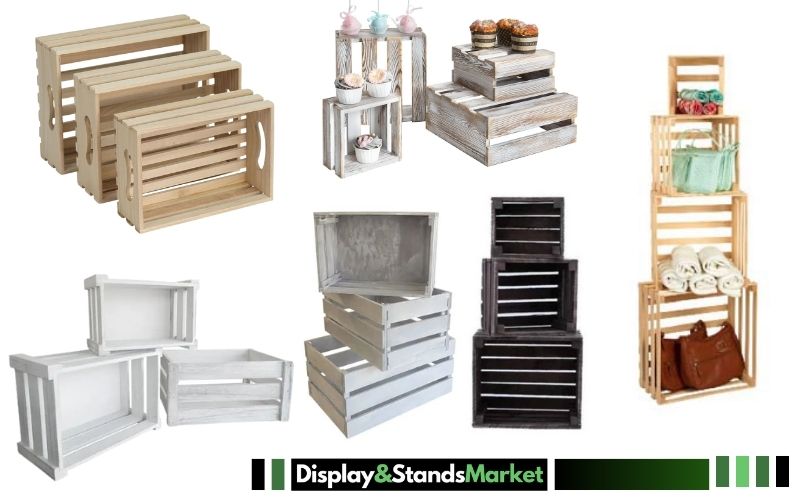
Nesting crates are collapsible, space-saving containers designed to showcase merchandise in a retail setting. The crates are designed to stack inside each other, allowing for efficient storage when not in use.
A nesting crate for product display is typically rectangular in shape, with open sides and a solid bottom. The crates are available in a variety of sizes, making them versatile for showcasing different types of merchandise. They often have built-in handles, making them easy to move around and position on display tables.
What materials are nesting crates made of
Nesting crates for product display can be made from various materials such as wood, plastic, and metal. Wooden crates are the most common, but plastic crates are also popular due to their lightweight and durable design. Metal crates are less common but offer greater durability for heavy-duty applications.
What nesting crate displays are best for
Nesting crates for product display is widely used in retail, Horeca (Hotel/Restaurant/Café), or event industries to showcase products. They are suitable for showcasing a wide range of merchandise, from fresh produce in grocery stores to handcrafted goods at craft fairs.
Similar products as nesting crate displays
Nesting crates for product display can also be called nesting boxes, stacking crates, or collapsible display containers.
Similar products to nesting crates include nesting tables, wooden crate display stands, wire baskets, and plastic storage bins.
However, nesting crates for product display have the unique advantage of being collapsible and stackable, making them ideal for efficient storage and transportation.
Choose the most suitable display stand
In choosing the most suitable wooden crate display stand, consider the unique aesthetics, durability, and versatility they offer. Whether for retail, events, or home decor, these stands enhance product visibility and ambiance.
The guide on Display Stands Market delves into various types, materials, and uses, aiding in selecting the perfect match for your needs. For an informed decision, refer to the detailed glossary provided in the article, ensuring your choice not only meets functional requirements but also complements the intended space.

